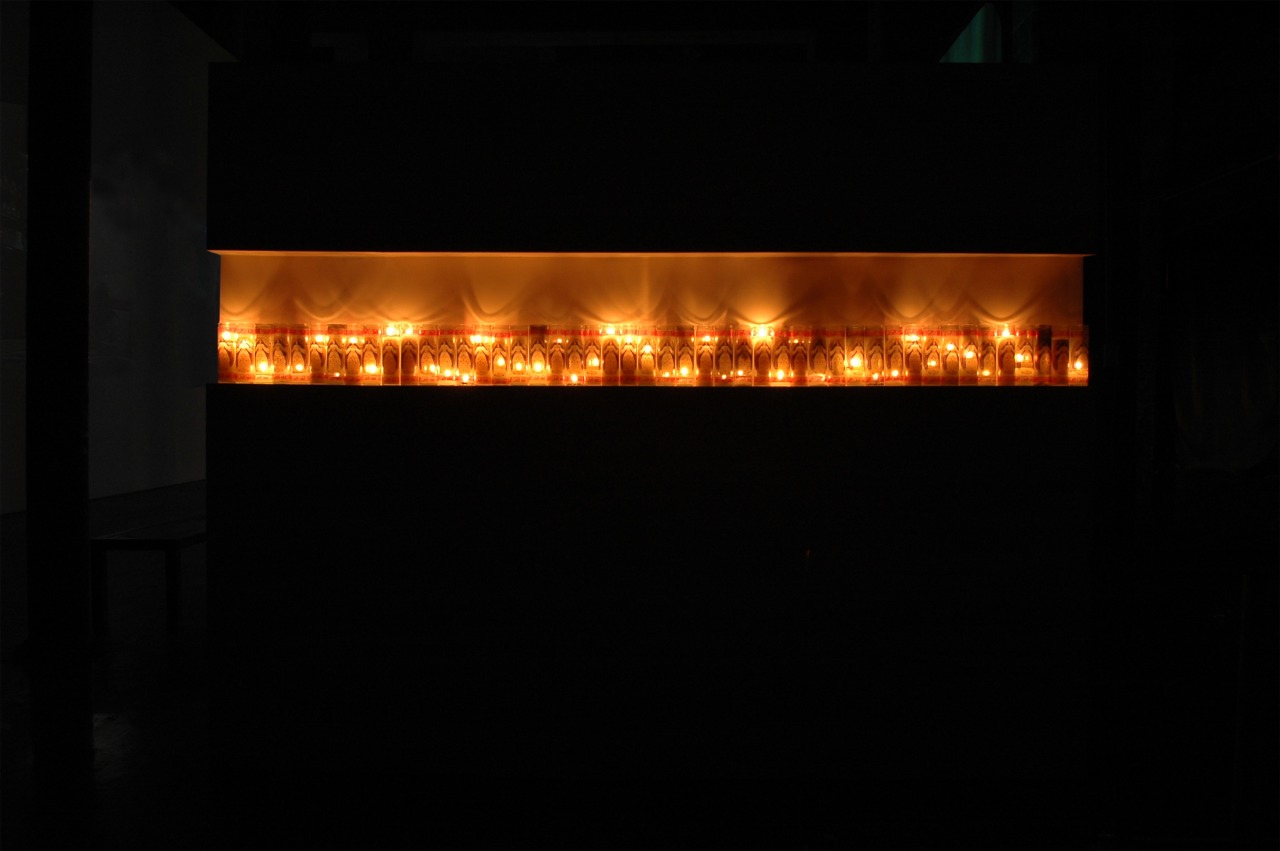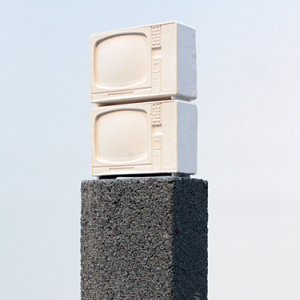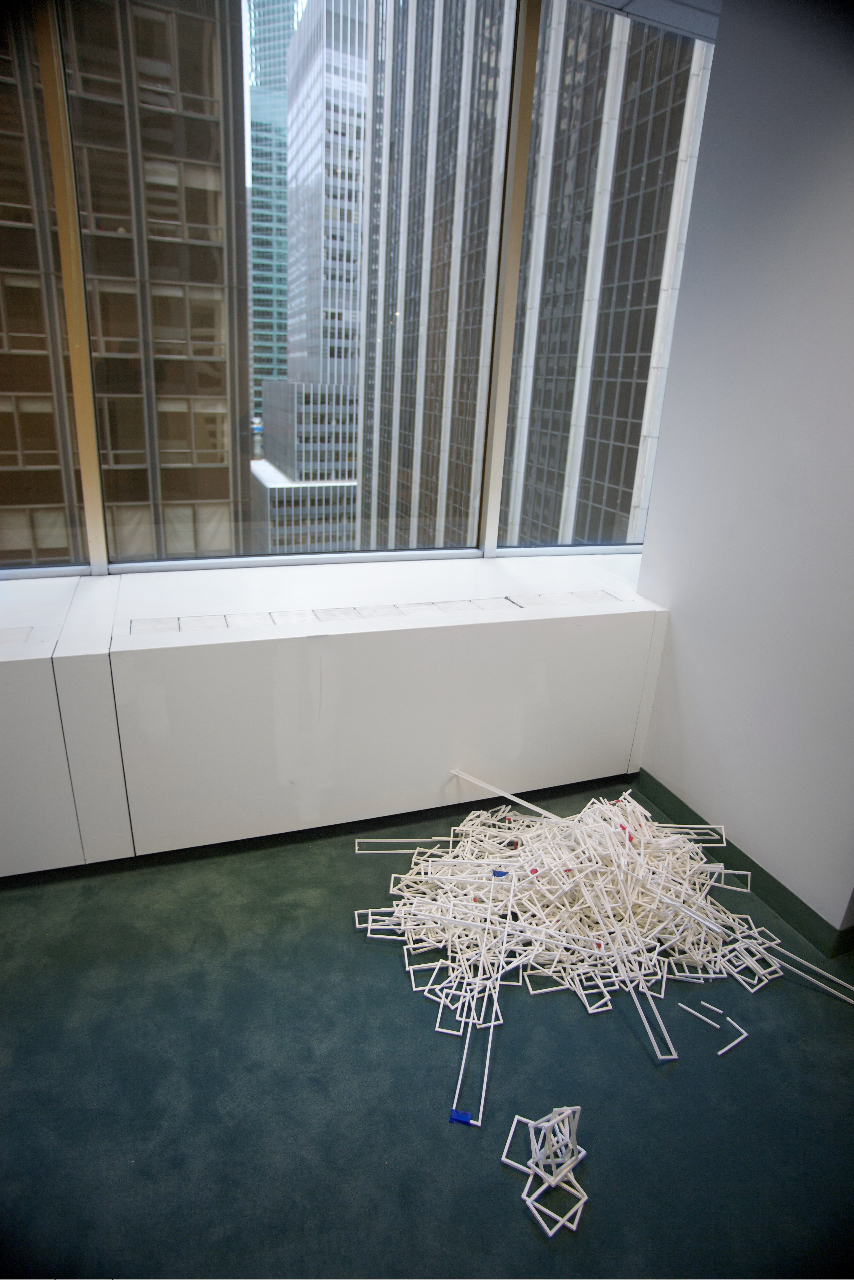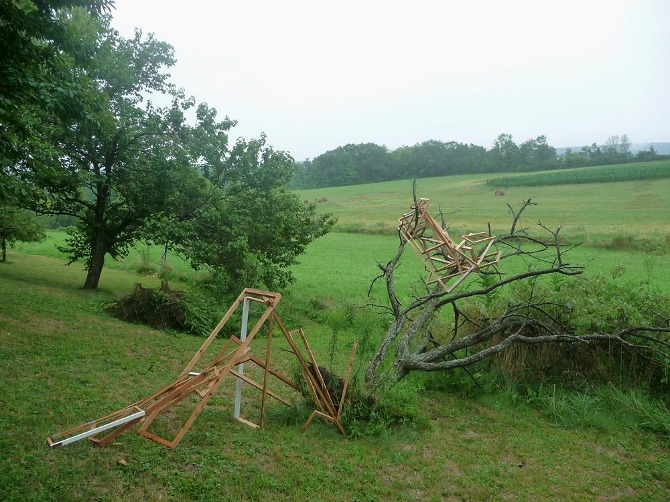
Esperanza Mayobre, Immigration Services
Esperanza Mayobre is a Brooklyn-based Venezuelan artist who “creates fictive laboratory spaces. Inserts the role of a hero, writing a role for herself in the work. Uses light as a metaphor for birth. Drawings to create infinite lines. Candles to create lines of light. Gives money away to talk about the third world countries debt. Dust to convert illegal to legal aliens. Elegant graffiti to portray urban chaos.”
ART (Inter) contributor Laura Salazar leads us in conversation with the artist:
LS: The Lodge Gallery is currently exhibiting your work, “Immigration Services.” Could you talk a bit about the different elements in this piece?
EM: “Servicios Migratorios / Immigration Services” consists of an altar, candles, legitimate dust envelopes, prayer cards of “Virgen de la Esperanza, Nuestra Señora Madre de los Inmigrantes / Virgin of Hope, Our Mother of the Immigrants”; a kit for immigrants in need to become legal aliens.
By placing an image of myself holding an American passport, money and a green card on the ubiquitous I created a figure named “Santa Esperanza” (Saint of Hope), the patron of the immigrants. This iconoclastic work comments on the American dream and the notion of the `self-made man’ as well as its (paradoxical) transformation into an object for devotion, prayer and desperate hope.

Esperanza Mayobre, Immigration Services
LS: Your work reflects profoundly on immigration issues, particularly of Latin Americans in the United States. Why did you move to New York? Why have you stayed?
EM: I have to admit I moved following someone. Paradoxically I thought it was easier to find a job and leave what I had behind than to find that someone. I was wrong. It is then when my immigration problems started. I first moved to Boston (2000). I was supposed to stay for only a couple years. My plan was to move afterwards to Denmark where I would continue my cabinetmaking studies (I have a degree in woodworking/furniture making). But I never left. One thing led to the other. No visa to work. Had to study. I did. Fine arts. Moved to New York (2003). Since then, never left. I thought I would. I have never really understood why I stayed. The more you stay the harder it is to leave. I prayed to the Virgin, I got my greencard. And now it’s too late, I like New York. It has a mix of a messy Latinamerican big city within the structure of an American one.
 LS: What are the most important elements of your identity as a Venezuelan that you hold on to after 10 years in New York?
LS: What are the most important elements of your identity as a Venezuelan that you hold on to after 10 years in New York?
EM: I think that by living abroad, I live in an eternal melancholy of what I still call home: Venezuela. Whatever this means is what my work has become about. I introduce my identity first, then myself. Hi, I am from Venezuela. My name is Esperanza. So I guess I am probably more Venezuelan now than when I lived home.
LS: How has the passing of time and the accumulation of experiences in the United States affected your work in terms of concept and medium?
EM: Where I come from oral tradition, big long lasting conversations and monologues are the everyday life. As a consequence I became a visual storyteller. I invent narratives that are related to everything that happens to me. Media or materials come after the idea. Though it is a very intuitive process, it is not a struggle. It just happens. Immigration needs to be said in lines of light. Flickering candles, as a metaphor to hope, walls, waiting and borders. Reconstructing and deconstructing the cities I live and come from, as elegant graffiti, with charcoal, graphite and erasers. To pay off the debt of third world countries I need to make money.
By living in continual translation between spanish and english; with a mind-set in two places, Venezuela and the US, I am constantly navigating from one to the other, back and forth. I lost track of a linear narrative.

LS: Your drawings in graphite and charcoal are based on images of a model you create, and each time you build a model it is informed by the environment you find yourself in. What are the thoughts that influence the layering and ordering of your foamcore frames into a chaotic arrangement?
EM: I started my wall drawings when I was doing the LMCC Workspace Residency in Lower Manhattan and a project at TAGA / Colección Mercantil in Venezuela. At that time I had been working with the grid for a while. I was ready to get rid of it but I couldn’t. Geometric Latinamerican art I think comes from the need of creating order in the middle of so much chaos. I was working on some drawings based on the organic chaotic landscape of Caracas. Once I was back in New York and I had the drawings in my studio/office with its geometric paradisiac Lower Manhattan view. In this environment the drawings of Caracas were read as landscapes of New York. That both the chaotic third world and organized first world cities could merge so easy just open that can of worms and thoughts that are present when I create the drawings.

LS: How do you feel when you give someone an eraser to alter or destroy your drawing? In the future, how do you see yourself evolving with your process and medium?
EM: Good and bad, laughter and disappointment, mad and amused. It is out of my control, the action and the result. That is what I like about it.
The box of erasers started as a passive object that intended to cause the thought in the viewer that he/she could potentially and eventually erase the already fading drawing. I did not intend to make it an action. But certain things have it’s own life. And this was one. It created a lot of conflict: do I leave the box or not beside the drawing. But it was this conflict that I wanted to create in others that was then created to myself, why I left it. One of the best experiences I ever had was seeing a group of teenagers erasing the drawings. Their response, involvement, redrawing, marks and traces of the erasers, gave something to the drawing that didn’t exist before.
I don’t know what is next. I probably will merge all my languages in a melting pot. I am curious myself of the consequences of an upcoming trip to Romania, a Brancusi pilgrimage, to visit his origins and the Endless Column. A new story will come from it.
Esperanza Mayobre: esperanzamayobre.com
Laura Salazar: laurasalazar.com

No comments yet.